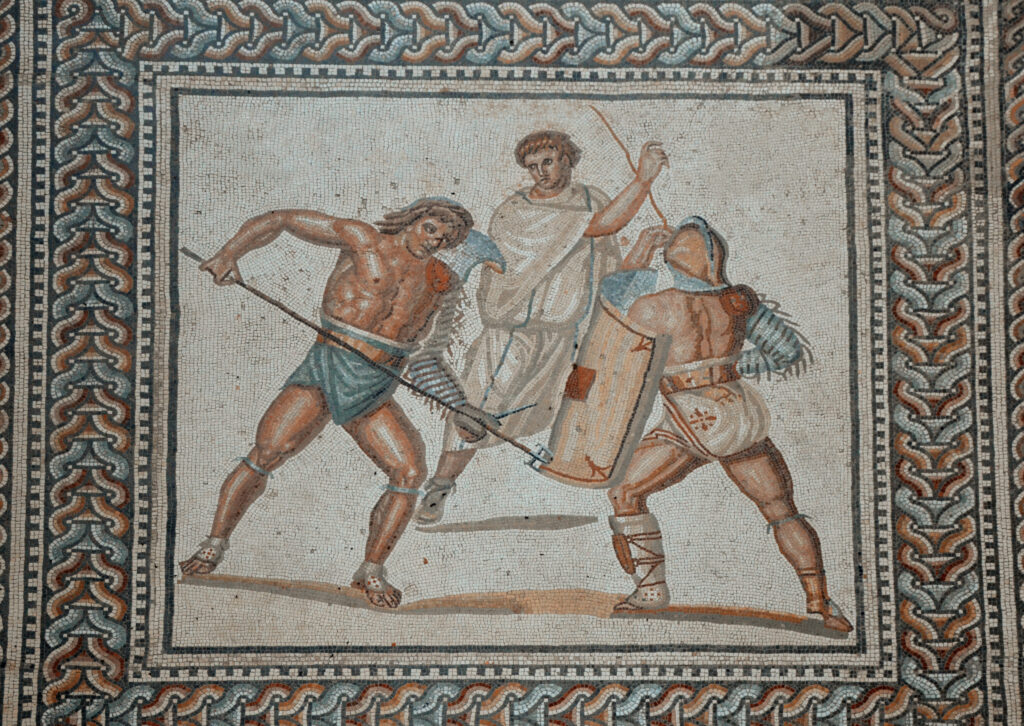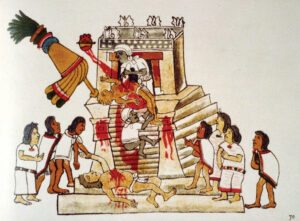
1. Spectators Drank Fresh Gladiator Blood as Medicine
Ancient Romans believed that drinking the warm blood straight from a slain gladiator’s throat could cure epilepsy. The Roman encyclopedist Celsus wrote in 40 AD about people who “freed themselves from such a disease by drinking the hot blood from the cut throat of a gladiator.” Vendors would sell the still-warm blood to eager crowds, and some believed consuming it would also enhance male sexual prowess.
This macabre practice continued for centuries, and even after gladiatorial games were banned around 400 AD, people sought the blood of freshly executed criminals as a substitute.

2. “Damnatio ad Bestias” – Executions Between the Gladiator Fights
During the midday intermission of gladiatorial games, condemned criminals were thrown to wild animals in a spectacle called “damnatio ad bestias” (condemnation to beasts).
The condemned were either tied naked to poles and left for the beasts or forced to run around the arena while being chased. Some executions were choreographed to re-enact Greek and Roman myths, with criminals cast as doomed characters.
One Christian martyr named Saturus became so blood-soaked after a leopard attack that the crowd mockingly celebrated his “baptism”. The Roman historian Suetonius wrote that when meat prices were too high, Emperor Caligula ordered that prisoners be fed to the circus animals, regardless of their crimes.
3. The Spoliarium – Where Dead Gladiators Were Stripped and Dumped
After death, gladiator corpses were dragged through the “Porta Libitinensis” (Gate of Death) to a chamber called the spoliarium, where they were stripped of weapons and armour.
If a famous gladiator had fallen, people would gather hoping to collect or dip into his blood, which they believed held extraordinary power. Most bodies were then thrown to wild animals or buried in mass graves outside the city.
Bodies of executed criminals were mutilated, their faces smashed in with a sledgehammer by an attendant dressed as Charon, the ferryman of the dead, before being dragged away with giant hooks.

4. Gladiator Sweat Was Sold as a Beauty Product
Roman women bought vials of gladiator sweat mixed with olive oil and dirt scraped from their bodies using a tool called a strigil. This mixture was sold outside arenas and used in facial creams and cosmetics by upper-class women, who believed it would brighten and rejuvenate their skin. The sweat was also considered an aphrodisiac.
These “souvenirs” were sold in elaborate containers, and the sweat of famous gladiators commanded premium prices.
5. They Ate Like Bodybuilders – But Got Intentionally Fat
Gladiators were nicknamed “hordearii” or “barley eaters” because their diet consisted mainly of barley, beans, and legumes with very little meat. This high-carbohydrate diet was designed to pack on subcutaneous fat, which served as a protective cushion against cuts and slashes in combat.
A layer of fat would shield nerves and blood vessels, allowing gladiators to sustain surface wounds that “look more spectacular” for the crowd while being able to fight on. After training, they drank a vile tonic made from charred wood or bone ash mixed with vinegar to supplement their calcium intake and strengthen their bones.

6. Mercy Killings With Hammer Blows to the Head
When a gladiator was defeated but still alive, an attendant dressed as Charon would enter the arena and deliver a fatal hammer blow to the head. Forensic analysis of gladiator skulls from a cemetery in Ephesus revealed that many had survived multiple blows to the head before their final deaths.
The “ideal” death was accepting the coup de grâce: stabbing through the shoulder blade into the heart while lying face down, or a downward sword thrust through the throat into the heart.
7. Pre-Battle “Last Meal” Banquets While Guests Watched Executions
The night before games, gladiators were given a lavish feast called the “cena libera,” similar to a prisoner’s last meal on death row. The most disturbing part came at elite Roman banquets. The Greek historian Nicolaus of Damascus wrote that after guests had their fill of food and drink, hosts would call in gladiators, and “no sooner did one have his throat cut than the masters applauded with delight”. Wealthy Romans literally watched men die for entertainment during dinner parties.
8. Their Lives Were Legally Worthless
Gladiators had no legal rights, and Romans who voluntarily joined their ranks had to swear an oath renouncing their citizenship, vowing: “I will endure to be burned, to be bound, to be beaten, and to be killed by the sword”. Condemned criminals forced to fight (called “noxii”) would be dragged from the arena by hooks inserted into their heels.
Burial rites could be denied to specific categories of criminals after execution, meaning the power of the state could extend to perpetual condemnation of souls. Even victorious gladiators lived knowing each fight could be their last, and many tried to kill themselves before scheduled executions to avoid the brutal spectacle awaiting them in the arena.
The Arena’s Legacy
Next time you see a film depicting gleaming, muscular gladiators as noble warriors, remember this: the reality was far more grotesque. These men were walking commodities whose bodies were harvested for their blood, their sweat, even their suffering. The crowds didn’t just watch them die – they drank from them, scraped products off their skin, and turned their executions into theatrical performances. The Roman arena wasn’t just brutal; it was a factory of horror that transformed human beings into consumable spectacle.
Sources
Primary Ancient Sources:
- Celsus, De Medicina (On Medicine), 40 AD
- Pliny the Elder, Natural History
- Seneca the Younger, On Anger
- Suetonius, The Twelve Caesars
- Martial, Book of Spectacles
Modern Archaeological & Academic Sources:
- Kanz, F. & Grossschmidt, K. “Stable Isotope Studies on Gladiators from Ephesus,” PLOS ONE, 2014
- Ephesus Gladiator Cemetery excavations (1993), Turkey
- Moog & Karenberg, “Gladiator’s blood as a cure for epileptics,” Journal of Neurosciences, 2003







